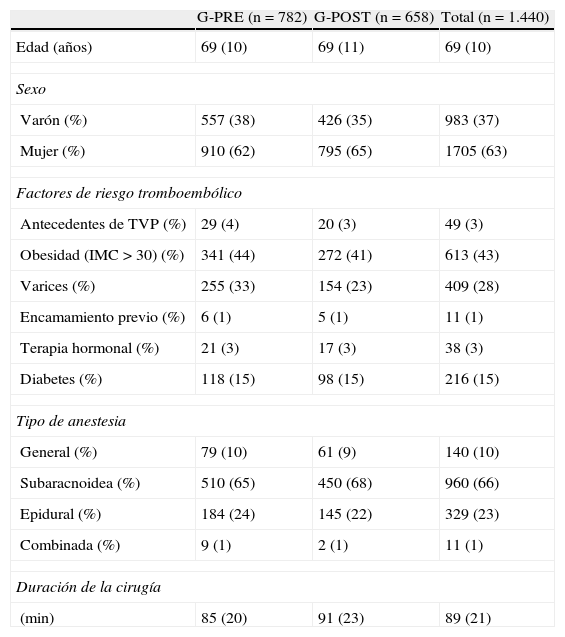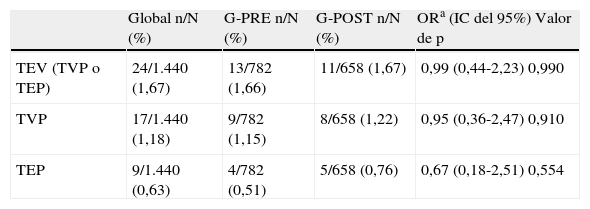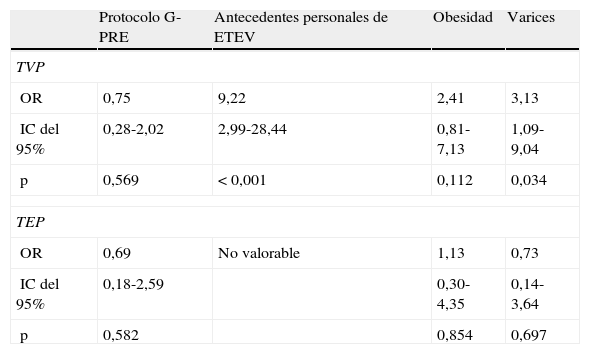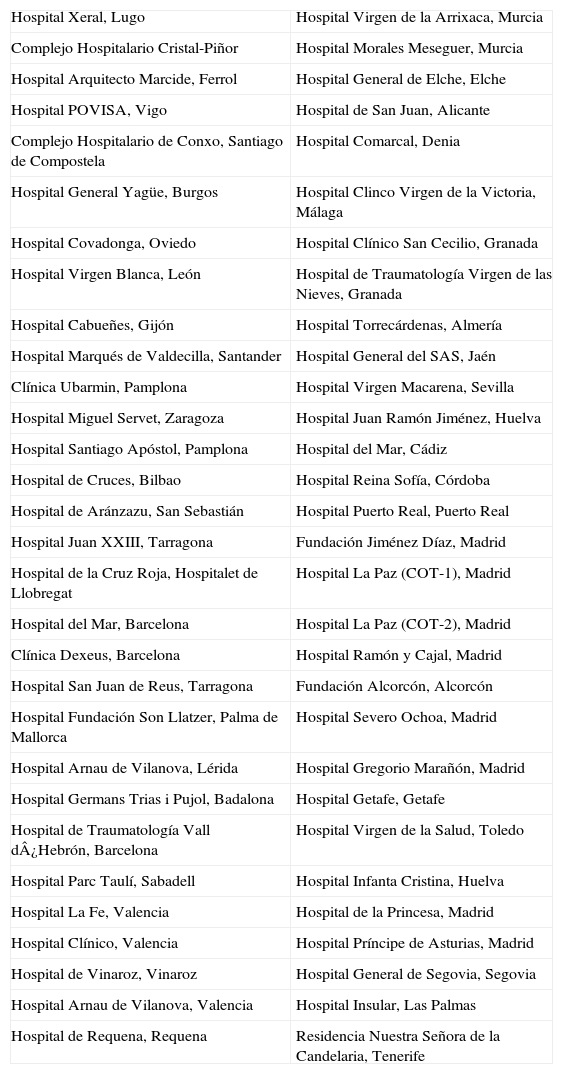Las heparinas de bajo peso molecular son la primera opción en la profilaxis de la enfermedad tromboembólica venosa en cirugía ortopédica mayor. El momento de inicio de su administración es controvertido. El objetivo del estudio fue evaluar la eficacia y seguridad de la enoxaparina en los pacientes intervenidos de artroplastia total de rodilla comparando el inicio en el preoperatorio frente al postoperatorio.
MétodosEstudio observacional, multicéntrico, retrospectivo, de práctica clínica habitual, para determinar la incidencia de trombosis venosa profunda y/o tromboembolismo pulmonar sintomáticos en la artroplastia total de rodilla. La tromboprofilaxis fue la pauta habitual de cada centro. Se incluyeron pacientes que recibieron enoxaparina 40mg/24h, bien la primera dosis 12h antes de la cirugía (±2h) (G-PRE) o entre 6 y 12h después de la misma (G-POST). El objetivo principal de seguridad fue la hemorragia. Se realizó un análisis de regresión logística multivariante para determinar la influencia real de cada variable.
ResultadosSe recogieron datos de 2.014 pacientes, de los que 1.440 fueron incluidos para el análisis de eficacia (782/1.440, 54% del G-PRE, y 658/1.440, 46% del G-POST). La incidencia media de eventos trombóticos sintomáticos fue de 1,67% (24/1.440). La incidencia de trombosis venosa profunda en el G-PRE fue del 1,15% frente al 1,22% en el G-POST (p=0,569 después del análisis multivariante) y la incidencia de tromboembolismo pulmonar fue del 0,51% frente al 0,76% respectivamente (p=0,582 después del análisis multivariante). Para el análisis de seguridad se incluyeron 1.422 pacientes. Hubo sangrado significativo en 59/788 del G-PRE y en 35/634 del G-POST (7,49 frente al 5,52% respectivamente; p=0,138).
ConclusionesEstos resultados sugieren que la tromboprofilaxis con enoxaparina (40mg/24h sc) en pacientes intervenidos de artroplastia total de rodilla presenta un perfil de eficacia y seguridad similar cuando se inicia su administración 12h antes de la cirugía o entre 6 y 12h después de la misma.
The low molecular weight heparins are the first option for the prophylaxis of venous thromboembolic disease in major orthopaedic surgery. The time of starting their administration is controversial. The aim of this study was to evaluate the efficacy and safety of enoxaparin in patients subjected to total knee replacement comparing the starting of it before and after the surgery.
MethodsAn observational, retrospective and multicentre study of normal clinical practice to determine the incidence of symptomatic deep venous thrombosis and/or pulmonary thromboembolism in total knee replacement surgery. Thromboprophylaxis was normal practice in each centre. Patients were included if they received the first dose of 40mg/24h of enoxaparin either 12h (± 2h) before the surgery (G-PRE) or between 6 and 12hours after the surgery (G-POST). The main safety objective was haemorrhage. A multivariate logistic regression analysis was performed to determine the real influence of each variable.
ResultsData was collected from 2014 patients, of whom 1440 were included for the analysis of efficacy (782/1440, 54% of the G-PRE and 658/1440, 46% of the G-POST). The mean incidence of symptomatic thrombotic events was 1.67% (24/1440). The incidence of deep venous thrombosis in the G-PRE was 1.15% compared to 1.22% in the G-POST (P=.569 after multivariate analysis) and the incidence of pulmonary thromboembolism was 0.51 compared to 0.76%, respectively (P=.582 after multivariate analysis). A total of 1422 patients were included for the safety analysis. There was significant bleeding in 59/788 of the G-PRE and in 35/634 of the G-POST (7.49% compared to 5.52%, respectively, P=.138).
ConclusionsThese results suggest that thromboprophylaxis with enoxaparin (40mg/24h sc) in patients subjected to total knee replacement surgery has a similar safety and effective profile when it is given 12hours before the surgery or between 6 and 12hours afterwards.
Artículo
Comprando el artículo el PDF del mismo podrá ser descargado
Precio 19,34 €
Comprar ahora















